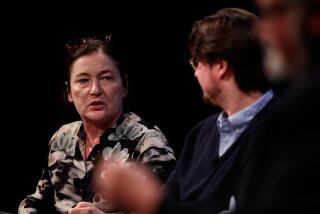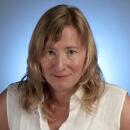Shrine for a Shroud
- Share via
HUNTINGTON BEACH — It’s been called the “linen enigma,” and the “most intensely studied artifact of modern science.” Detractors label it an “obvious fraud,” and some religious scholars weigh in with a more generous “pious forgery.”
Now, a local gynecologist has brought the mystery, the history and the nasty disagreement surrounding the Shroud of Turin to Orange County--more than 6,000 miles from the town where the real thing lies protected in an Italian cathedral.
Dr. August David Accetta, who harbored a years-long fascination with the cloth that some believe to be the burial shroud of Jesus, has poured $100,000 of his own money into the Shroud Center of Southern California, which opened eight months ago.
The small exhibition space and nonprofit research center tucked away in a Huntington Beach office park features a definite point of view: all research and photographic images on display support arguments for the shroud’s authenticity.
But Accetta--a chemist by training who has launched his own research into the life-sized smoky image of a man on the shroud using nuclear medicine techniques--insists his center isn’t hunting for converts.
“We really need to emphasize what we can demonstrate,” he said. “I’ve always felt that if you couldn’t demonstrate something, it was just your opinion.
“When I got started on this, I really didn’t care,” Accetta added, still dressed in surgical pants as he offered a quick tour of his center. “But I read 200,000 hours of peer-reviewed research and 95% of it is in favor of the shroud being authentic. What I found was the public is being misinformed and I made an attempt to create a center that would generate accurate information.”
The yellow linen that surfaced in the hands of a Frenchman in the 14th century shows a dusky image of a man, with marks on his head that believers argue were produced by a crown of thorns, lacerations on his back, stigmata on his hands and feet, and a severe wound on his right side.
The cloth has been zealously studied.
Fibers were torn off with tape in a 1978 round-the-clock, five-day expedition. Photographic replications of its markings have since been tested with nearly every form of science imaginable--from NASA machinery designed to detect the topography of Mars to X-ray replications that convinced supporters that the image of a crucified man inside the shroud burned through it in a sudden burst of energy.
The object of debate, reverence and parody has also been carbon-dated, the disappointing results of which showed it to have originated in the Middle Ages, sometime from 1260 to 1390.
Accetta, however, joins the ranks of researchers who believe the 1988 carbon-dating meant to lay the fierce debate to rest did nothing of the sort.
“To use the buzz phrase, it was garbage in, garbage out,” said Accetta, who argues that the wrong part of the shroud was sampled and that dating failed to take into account fire damage to the cloth and other potential contamination.
Accetta is a relative newcomer to the so-called “shroud crowd,” a group of about 100 self-taught experts worldwide who dedicate themselves to examining the enigmatic cloth through scientific means, said Dr. Alan Whanger. Whanger is a physician and retired professor from Duke University who has conducted original research on the shroud since the late 1970s.
*
Accetta has been warmly welcomed to the crowd.
“I was very pleased that Dr. Accetta decided to do this,” said Whanger, who attended the opening of Accetta’s museum last May. “His particular service is providing a locale that has a lot of visual material available. You sort of have to see it to believe it. Most people, what they recall is the carbon-dating fiasco.”
Physicist John Jackson, who led the 1978 expedition to analyze the Shroud in Turin and now runs the Turin Shroud Center in Colorado with his wife, Rebecca, agrees:
“We have warm feelings for Gus and his work. He’s trying in his own way to promote the understanding of the shroud in Southern California. To our minds, wherever the shroud is better understood, we think that’s a positive thing.”
A small gift shop in the center’s office features shroud memorabilia such as videos, literature and photos. A second room runs through the chronology of shroud research: framed photographs of the enlarged image of the mystery man’s face, X-ray overlays that show how close the image comes to matching the human skeleton, and more.
A third room features a big-screen television for shroud videos, but the prize lies in the largest room: four photographic, full-sized replicas of the 14.3-foot-long shroud in back-lit view boxes from all angles.
All of it was previously stored in the Huntington Beach home Accetta, 37, shares with his wife and two daughters, ages 3 and 1. “My 3-year-old can see an image and say, ‘Look, Daddy, that’s Jesus,’ ” he said with a laugh.
He built the view boxes himself. And the 20 hours a week he spends at the center are not compensated, Accetta said. While he plans to apply for grants soon, so far the funding has come from himself, with some donations from other sympathizers. He is conducting research with four other scientists: a nuclear medicine physician, a particle physicist, a forensic pathologist and an imaging analyst.
Accetta was raised Roman Catholic but says he was agnostic for eight years. His wife, Accetta said, is a New Testament Protestant who supports him and “accepts” his convictions about the shroud.
He dates his obsession with the shroud five years back, when he says, simply, “something clicked.” While he “thinks about it 24 hours a day” and often talks his sideline up to other doctors, Accetta said he is careful not to raise the issue with his patients.
“I try to keep it separate,” he says.
The shroud first surfaced in Lirey, France, in 1357 and was immediately revered as the burial cloth of the crucified Jesus, although not without controversy even then. It was sold to Italy’s royal Savoy family, who moved it in 1578 to the Cathedral of St. John the Baptist in Turin.
Agreement pretty much ends there.
Some analysis of pollen grains on the shroud place it in Jerusalem in the 1st Century. Others say the pollen was from later contamination. Some researchers say apparent blood on the shroud has been scientifically proven to be real. Others say it’s paint or pigment.
Skeptics offer a harsh assessment of the believers’ research.
“It absolutely does the public a disservice,” said Joe Nickell, a senior research fellow with the Committee for the Scientific Investigation of Claims of the Paranormal in Amherst, N.Y. He is one of the best-known disbelievers in the shroud’s authenticity.
“The evidence is very clear that this is just a graven image, to use a religious term, and is not suitable for worship,” Nickell said. “To attempt to use science to justify this fake amounts really to a rape of science.”
*
Mainstream academia has in general steered clear of the latest debates and tests of the cloth’s veracity.
“Most liberal Catholic and Protestant scholars see the Shroud of Turin as sort of a pious forgery,” said Ben Hubbard, chairman of the religious studies department at Cal State Fullerton. “I guess people find some comfort in these kinds of things and I respect that, but I think it’s all a little obsessive. They’re trying to give a scientific facade to something that is a matter of faith. . . . If you can prove the resurrection with a shroud, is that really faith?”
The Roman Catholic Church, which has custody of the shroud, has long supported research on it and takes no formal position on its authenticity, said Msgr. Lawrence J. Baird, spokesman for the Diocese of Orange.
Scholars from 92 disciplines have looked at the shroud, Baird said, adding: “A lot are negative and say it’s a forgery. The church will stand finally by whatever is decided upon by these scholars.”
Authentic or not, the shroud will be on public display--it has been viewed only a handful of times in this century--in April 1998 and again in April 2000.
Locally, Accetta says his museum has drawn about 1,500 visitors since the grand opening. The Newport/Irvine Harbor Interfaith Council plans to visit the center next month.
It is open most weekday afternoons from 2 to 6 p.m., and lectures by Accetta--who has given talks on the shroud to local churches and civic organizations--can be arranged in advance. The center can be reached at (714) 375-5723.
“If this was the image of Muhammad, I’d change my religion in a minute,” Accetta said. “I don’t believe in providence. I don’t believe in fate, yet I’ve found myself drawn into this. It’s much easier for me to accept the miracle at this point than it is to prove it a forgery using science.
“A lot of my friends don’t understand. But hey, if I could put it down, believe me, I would.”
More to Read
Sign up for Essential California
The most important California stories and recommendations in your inbox every morning.
You may occasionally receive promotional content from the Los Angeles Times.










